Top Trends in Homepage Design for Ecommerce: Transform Your Online Store in 2024
- Categories :
- Website Designing
- Ecommerce Development

A successful homepage design for ecommerce determines if visitors browse or bounce. This blog provides valuable recommendations on creating an attractive homepage for an online store. These tips can greatly boost sales by directing visitors toward making a purchase. Discover the skill of designing a user-friendly and reliable ecommerce store design homepage that drives conversions without getting overwhelmed by technical intricacies.
Creating a visually appealing landing page for your simple ecommerce website is crucial in today's competitive online market. You can transform your online store into a sales powerhouse with the right design elements and user-friendly features. Here are some valuable tips to help you achieve an appealing landing page for your e-commerce website.
Firstly, it's important to focus on simplicity and clarity. A cluttered ecommerce homepage can overwhelm visitors and drive them away. Instead, choose a clean, organized layout highlighting your products or services. Use high-quality images and concise, compelling copy to grab attention and convey your brand message effectively.
Next, ensure effortless navigation for your website's visitors. Implement a clear and intuitive menu structure that allows users to find what they want easily. Incorporate search functionality to enable quick product searches, saving your customers time and effort. Additionally, consider adding filters and sorting options to help users refine their search results.
Another key aspect of a successful website homepage design is trustworthiness. Display trust signals such as customer reviews, security badges, and guarantees prominently on your landing page. This will instill confidence in your visitors and encourage them to purchase. To further build trust with your audience, ensure your website is secure and user data is protected.
Furthermore, optimize the design of your e-commerce site homepage for mobile devices. Offering a smooth mobile experience as more people use smartphones and tablets for online shopping is important. Ensure that your website is responsive and loads quickly on all devices. Simplify the checkout process for mobile users to minimize friction and increase conversions.
Lastly, don't forget to incorporate strong calls-to-action (CTAs) throughout your ecommerce homepage. Use compelling language and visually appealing buttons to guide visitors toward purchasing. Ensure your CTAs like "Buy Now," "Add to Basket," or "Register" are prominently displayed and tactically positioned to grab attention.
By implementing these tips, you can create a visually appealing and user-friendly homepage that drives conversions and boosts sales. Remember to regularly analyze and optimize your online store design based on user feedback and data to continuously improve your online store's performance. With the best ecommerce design homepage, you'll be well on your way to success in the ever-evolving world of e-commerce.
5 Best Ecommerce Website Design Examples in 2024
- Bestntop
Bestntop is one of the great examples of a good homepage. This eCommerce website has been designed to make travel outdoor products very attractively. The beauty of the homepage on this website adds to the appeal of the best categories and brands, as well as the large banners. This has enabled customers to choose products easily and design the homepage to be soothing to the eyes.
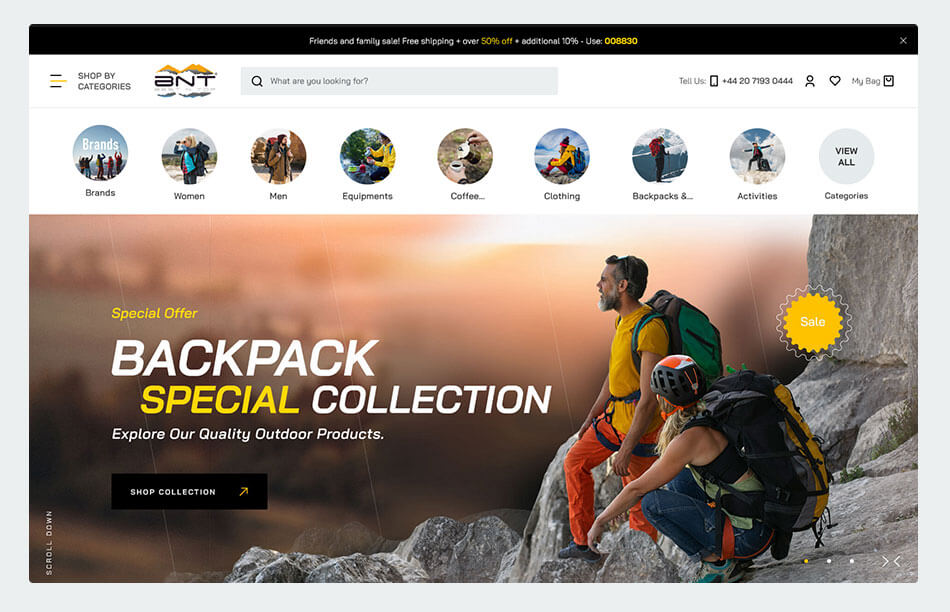
- Sport-in-place
The client specifically desired an extensive homepage for their ecommerce website, aiming for an exceptional user experience that encompasses all product categories. The choice of a vibrant color scheme, predominantly featuring an appealing blue, adds a touch of attractiveness and superiority, bring into line smoothly with the prime brand identity. The result is a visually stunning homepage personalized precisely to meet the client's preferences and requirements.
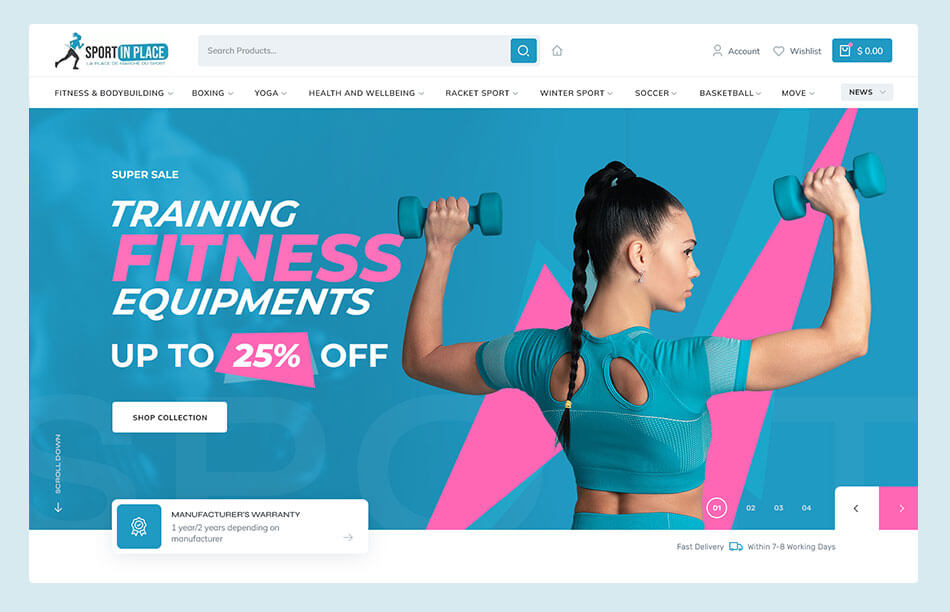
- Patioproductions
The Patioproductions homepage stands out for its exceptional blend of concept, design, and allure. Elevating its visual aesthetics, an instinctive white template has been tastefully incorporated, creating a captivating ambiance. The thoughtful arrangement of categories ensures user-friendly navigation, allowing visitors to effortlessly make their selections. Additionally, owner Ben Harvey articulates his vision directly on the homepage, providing a personal touch that enhances the overall appeal of the website.
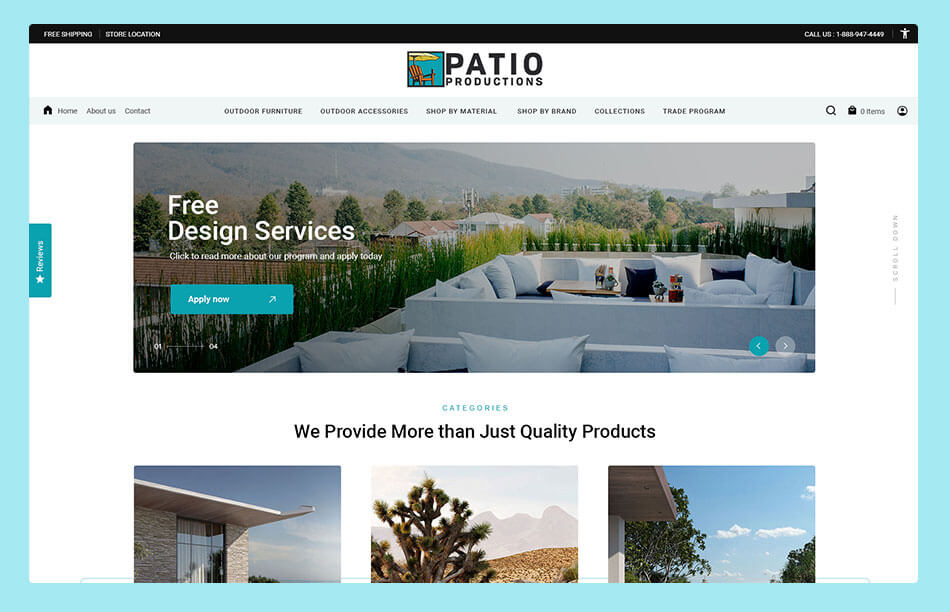
- Ayurplan
Ayurvedic medicines represent a timeless treasure, invaluable in both ancient and contemporary life. When entrusted with the creation of an ecommerce store, owner Dibin expressed a vision where visitors would immerse themselves in an authentic Ayurvedic atmosphere upon entering to Ayurplan webstore. A glimpse at the homepage of this ecommerce website invites you to step into the very essence of Ayurveda, promising a fascinating journey through the frontiers of this ancient healing tradition.
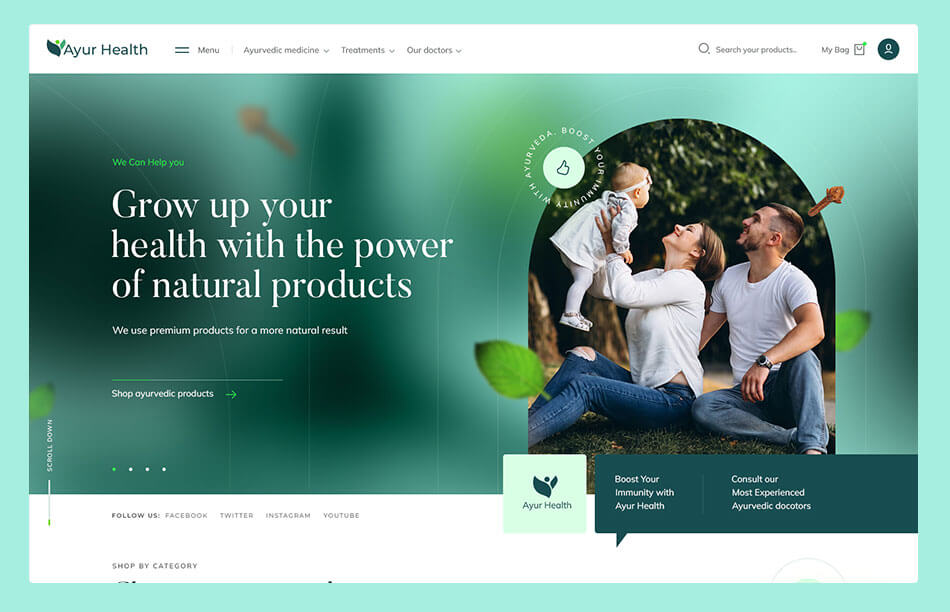
- Syso
Syso Store complies an array of exquisite products, catering to the varied and essential needs of every household. Upon inspecting the captivating product images, we embarked on crafting a homepage design that sets itself apart with its diversity and simplicity, distinguishing it from other ecommerce platforms. The initial design, cherished by the owner, perfectly captured the vision envisioned for SYSO. Together, we have not only conceptualized but brought to life a vibrant and functional ecommerce homepage. Take a moment to travel the allure of this beautifully designed ecommerce website homepage.
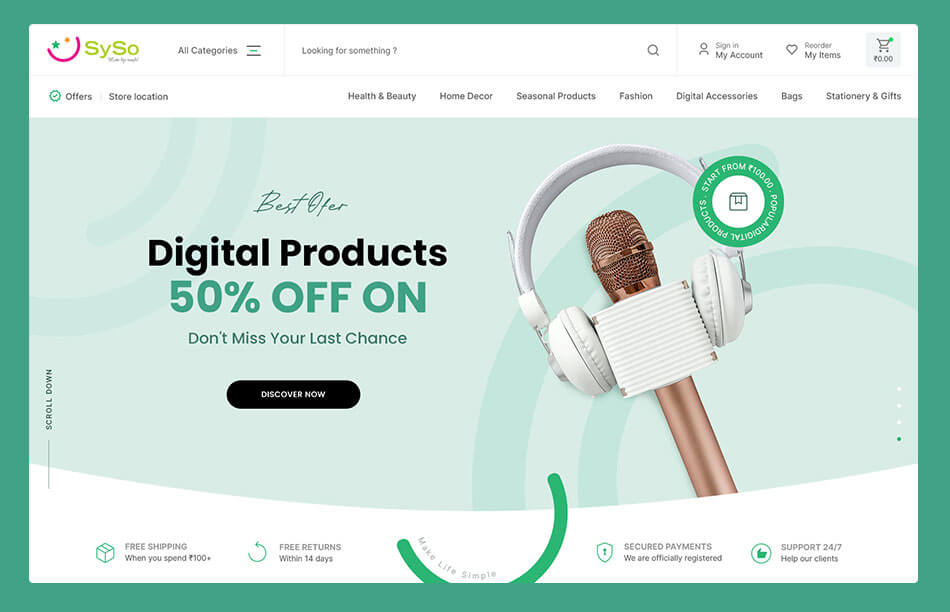
8 Best Practices Homepage Design for Ecommerce Website
- Crafting a Trustworthy First Impression
- Visual Appeal: Engaging Customers with High-Quality Imagery
- Streamlining Navigation for Enhanced User Experience
- Converting Visitors with Strategic Calls to Action
- Personalization: Tailoring the Shopping Experience
- Building a Responsive Webshop Design for All Devices
- Showcasing Social Proof to Inspire Confidence
- Highlighting Value Proposition and Brand Story
Regarding ecommerce homepage design best practices, a strategic combination of visually appealing elements, intuitive navigation, clear calls to action, and compelling product showcases is essential. Utilizing high-quality images and engaging visuals, implementing a responsive and user-friendly layout, and prominently featuring top-selling or new products can capture visitors' attention. Additionally, incorporating intuitive search and navigation options, concise and persuasive copy, and strategically placed calls to action can guide visitors toward purchasing. Lastly, ensuring fast loading times, clear branding, and seamless integration with promotions or special offers contributes to a successful ecommerce homepage design, ultimately enhancing the user experience and driving conversions. Please follow the best practices below to design a very efficient homepage for your e-commerce website.
-
Crafting a Trustworthy First Impression
In the world of ecommerce, first impressions are everything. Your website serves as the digital storefront of your business, and it’s often the first point of contact for potential customers. Creating a professional, trustworthy image that inspires confidence is paramount in making customers feel secure in shopping with you.
Examining how security features, trust badges, and clear contact details can elevate your best ecommerce website design is worthwhile.
-
Highlighting Security Features
In today’s digital age, security is paramount. Customers must trust that their sensitive data, such as credit card information, is safe. Having clear and prominent security features on your ecommerce website is of utmost importance.
The SSL certificate utility and reputable payment gateways guarantee the safety of customer data and foster a sense of trust during transactions.
-
Showcasing Trust Badges
Trust badges and seals serve as tangible proof of your ecommerce store’s credibility. Displaying these key element badges in your ecommerce homepage template, particularly those from reputable sources, can enhance your store’s credibility and increase customer trust, leading to a more effective sales funnel.
New visitors who see these badges feel more confident that their sensitive information is safeguarded, increasing their likelihood of purchasing.
-
Providing Clear Contact Details
Providing clear and easily accessible contact details is another essential element of building customer trust. It reassures customers that help is readily available should they need it. Featuring your company’s contact information enables customers to reach out easily for inquiries or assistance. This includes Enhance the visibility of contact details on your ecommerce website by improving how you display them:
- Company address
- Phone number
- Mailing address
- Social media links
Enhance the visibility of contact details on your ecommerce homepage by improving how you display them:
- Designing an easily accessible ‘Contact Us’ page linked from the main menu or footer
- Integrating a prominent call-to-action (CTA)
- Strategically place the contact form at the top of the page on the right-hand side.
-
-
Visual Appeal: Engaging Customers with High-Quality Imagery

A picture is worth a thousand words, which could not be truer in ecommerce. High-quality photos are powerful tool for engaging customers, enhancing the visual appeal of your ecommerce website, and influencing their purchasing decisions.
From professional product photography to dynamic sliders and immersive video content, it’s worth understanding how visual elements can transform your online store.
-
The Power of Product Photography
High-quality product photography can make a world of difference to your ecommerce platform. Providing high-quality product images can stimulate an emotional response in your customers, encouraging them to purchase.
To enhance their effectiveness, consider including the following elements:
- Professional images of products from various angles and contexts
- Integrating a 360° video demonstrating different product features
- Providing a zoom feature for images
- Minimizing the use of stock images to maintain realness.
-
Implementing Dynamic Sliders
Dynamic sliders are an excellent tool to present promotions, highlighted products, and important information engagingly on your online store. Designing dynamic sliders with user interaction in mind enhances customer engagement and boosts conversion rates. Some recommended ecommerce homepage design best practices for implementing dynamic sliders include:
- Using high-quality photographs
- Including 3-5 slides
- Placing call-to-action buttons strategically
- Minimizing unnecessary animation
- Optimizing for search engines
- Designing with mobile users in mind.
-
Integrating Video Content
Source: Provident MotorsIn the age of digital marketing, video content has become a powerful tool for ecommerce website design. Integrating video content onto your ecommerce website offers a more immersive shopping experience and showcases your products in action. Video content engages customers actively and demonstrates.
- Increase conversion rates.
- Improve customer engagement.
- Boost brand awareness
- Enhance product demonstrations.
Including video content in your e-commerce strategy can take your online businesses to the next level and drive more sales.
Best practices for integrating video content on your ecommerce website design include:
- Keeping videos concise
- Highlighting product features
- Employing storytelling
- Optimizing for mobile
- Understanding the audience
- Integrating a call to action
- Establishing clear goals and performance indicators.
-
-
Streamlining Navigation for Enhanced User Experience
A well-organized ecommerce website that's easy to use can make customers happy. Let us explore how making the search bar better, simplifying menus, and customizing navigation can enhance the friendliness of your site's homepage. These steps are pivotal in understanding how to build an ecommerce website step by step, ensuring a user-centric approach and a seamless shopping experience.
-
Optimizing the Search Bar

An efficient and optimized search bar is crucial in enhancing the user experience on your ecommerce website. By implementing search engine optimization strategies, you enable customers to quickly and efficiently find products, reducing frustration and bounce rates and elevating customer satisfaction and conversion rates.
To ensure an optimal search bar, consider:
- Positioning the search box at the top of the page
- Making it large and distinctive
- Including text such as search suggestions.
- Using different colors, fonts, and a search icon
- Implementing search ahead or autocomplete options.
- Adding product filters
-
Simplifying Menu Structures
A well-structured and simplified menu can significantly enhance the user experience on your ecommerce website. Key considerations to keep in mind when simplifying menu structures on ecommerce websites include:
- Ensuring clear visual hierarchy and consistent labels
- Avoiding deep or complex hierarchy
- Steering clear of confusing navigation structures
- Refraining from unconventional navigation approaches
- Maintaining visibility of the navigation menu
- Limiting the number of options
- Ensuring the inclusion of relevant options
- Maintaining consistency across different devices.
-
Personalizing Navigation Paths
Personalized navigation paths can greatly enhance the user experience on ecommerce websites. Tailoring navigation paths based on user behavior and preferences results in a unique shopping experience for each customer. Recommended strategies for implementing personalized navigation paths include:
- Experimenting with different menu designs and placements
- Customizing the order of items in filter menus based on user browsing history
- Applying different messaging variations
- Organizing logical structure to ensure prominent access to key pages
- Maintaining consistent navigation
- Introducing categories and subcategories for new products.

Looking to create interactive design for eCommerce website?
Elevate your online presence with Intellect Outsource's expert web designers. Transform your design vision into captivating, interactive, and high-converting experiences for your e-commerce website. Trust us to bring your ideas to life. Share your thoughts, and let's create something extraordinary together.
Get your free quote now ! -
-
Converting Visitors with Strategic Calls to Action
Strategic calls to action (CTAs) are crucial in converting visitors into customers. A well-crafted CTA can guide customers through their buying journey, encouraging them to take action. This section will cover crafting compelling CTAs, balancing multiple CTAs, and encouraging immediate engagement to boost the conversion rate of your ecommerce website.
-
Crafting Compelling CTAs
A compelling CTA can greatly enhance the effectiveness of your ecommerce website by guiding customers through their buying journey and encouraging them to take action. Here are some tips for crafting compelling CTAs:
- Communicate a clear message.
- Utilize strong verbs.
- Evoke emotion or enthusiasm.
- Provide a reason to take action.
- Be concise and action-oriented.
- Use impactful language.
These tips can create CTAs that drive conversions and boost your ecommerce sales.
-
Balancing Multiple CTAs
While it is important to use CTAs strategically, balancing multiple CTAs on your homepage is crucial to prevent overwhelming visitors and ensure a clear focus on the primary action you want them to take. Consider including a subtler secondary CTA that doesn’t compete with your primary CTA.
This can help guide customers through their buying journey without overwhelming them with too many options.
-
Encouraging Immediate Engagement
Encouraging immediate engagement can be a powerful way to convert visitors into customers. By placing CTAs prominently on your homepage and using persuasive language, you can increase the likelihood of customers taking immediate action. Some successful ecommerce websites that have effectively promoted immediate engagement include:
- Bite
- Temu
- Rollink
- G Pen
These websites have utilized expandable chatboxes, game-like features, integration, and well-made landing pages to encourage immediate engagement.
-
-
Personalization: Tailoring the Shopping Experience
Personalization is a powerful tool for enhancing the shopping experience on your ecommerce website. By leveraging user data, offering dynamic product recommendations, and delivering customized content, you can create a shopping experience tailored to each individual’s preferences and needs.
Investigating how these personalization techniques can revamp your ecommerce business is beneficial.
-
Leveraging User Data
Leveraging user data can greatly enhance the shopping experience on your ecommerce site. Here are some ways to do it:
- Analyzing customer behavior, interests, and demographics
- Enabling a customized shopping experience for each individual
- Creating a more immersive and effective customer journey
Use web tracking, surveys, and customer registration to gather this valuable data.
-
Dynamic Product Recommendations
Dynamic product recommendations can significantly enhance the shopping experience on your ecommerce site by providing personalized product suggestions based on user behavior and interests. This can make product discovery a breeze and increase the likelihood of conversion. Some successful ecommerce websites that utilize dynamic product recommendations include:
- Sephora
- Farrow & Ball
- The Cosmopolitan of Las Vegas
- Coca-Cola’s ‘Share a Coke’ campaign
-
Customized Content Delivery
Personalized content can improve shopping on your online shop by making customers feel understood and valued. This can influence their loyalty and purchase behavior, leading to increased sales.
Tailor content for each customer by using AI and personalization techniques. Provide customized blog posts, newsletters, and social media updates based on their preferences, behavior, and purchase history.
-
-
Building a Responsive Webshop Design for All Devices
In today’s digital age, customers shop on various devices, from desktop computers to smartphones and tablets. Whether you're looking to learn how to create an ecommerce website or already have one, ensuring a responsive design is crucial for providing a seamless user experience across all devices.
This section ensures your website looks great and is easy to use on mobile phones. We are also ensuring that it operates quickly and smoothly.
-
Adapting Layouts for Mobile Users
When optimizing your site for mobile gadgets, aligning the website design with navigation needs is important. This includes adding a product search with filtering options and a hierarchical menu. Conduct thorough testing to ensure proper screen size and feature availability adjustments are in place.
Additionally, considering custom ecommerce website design for mobile users becomes crucial. Tailoring your online store's layout for mobile users is essential to a smooth shopping experience. Layout optimization for various screen sizes ensures easy navigation, whether customers use a desktop computer or a mobile device.
-
Ensuring Touch-Friendly Interfaces
As mobile shopping becomes increasingly popular, it's important to have touch-friendly interfaces on your ecommerce site. A touch-friendly interface is designed for effortless interaction on touch-enabled devices, ensuring mobile users a smooth and enjoyable shopping experience.
To optimize your ecommerce site for touch-friendly interfaces, consider implementing the following strategies:
- Use a responsive layout to ensure your website design adapts to different screen sizes and orientations.
- Optimize your website speed for faster loading on mobile device.
- Conduct thorough testing on different devices to verify touch-friendliness and ensure a seamless user experience.
- Incorporate a viewport meta tag to ensure proper scaling and display on cell phones.
- Declutter your website by removing unnecessary elements and improving usability on mobile devices.
By implementing these strategies, you can create a user-friendly and touch-responsive ecommerce site with an effective ecommerce homepage design, paving the way for a successful ecommerce business.
-
Prioritizing Speed and Performance
Speed and performance are crucial elements of a successful ecommerce website. A fast, responsive website can keep customers engaged and reduce bounce rates, leading to improved sales and customer satisfaction. To enhance your site’s speed and performance, consider strategies like optimizing images, leveraging browser caching, and learning how to set up an ecommerce website efficiently. These steps can significantly impact your site's responsiveness and overall user experience.
- Selecting a performance-optimized hosting solution
- Compressing your images
- Minifying and combining files.
- Enabling browser caching
- Reducing server response time
- Utilizing a content distribution network
- Optimizing your website’s code
- Optimizing your CSS
- Prioritizing above-the-fold content
- Decreasing the number of HTTP requests.
-
-
Showcasing Social Proof to Inspire Confidence
Social proof is a powerful tool for inspiring confidence in your ecommerce store. Displaying customer testimonials, ratings, reviews, and user-generated content offers concrete evidence of your product's value and your brand's reliability.
We’ll delve into how these types of social proof can amplify your ecommerce website.
-
Featuring Customer Testimonials
Customer testimonials are a powerful form of social proof that can build trust and credibility in your brand. Featuring testimonials from satisfied existing customers on your ecommerce homepage reassures potential customers of the quality and value of your products.
Explore featuring a testimonial from each primary customer group, adapting the showcased testimonial to match visitor demographics, and staying engaged on relevant review platforms.
-
Displaying Ratings and Reviews
Ratings and reviews provide valuable social proof to help customers make informed purchase decisions. By displaying ratings and reviews on your ecommerce site, you can provide customers with genuine feedback from other customers, enhancing your brand’s credibility and trustworthiness.
To ensure the visibility of your ratings and reviews, consider including them on product pages along with clear product names, descriptions, images, and an easy-to-use add-to-cart button. Additionally, organizing your offerings into well-defined product categories can enhance user experience and searchability.
-
Utilizing User-Generated Content
User-generated content, including customer photos and reviews, can greatly enhance the credibility and trustworthiness of your ecommerce store. By showcasing real-life experiences with your products, you can:
- Create a sense of community and authenticity that resonates with potential customers
- Increase customer engagement and interaction
- Provide social proof and build trust
- Generate user-generated content for your marketing efforts
Some successful ecommerce websites that utilize user-generated content include Sephora, Farrow & Ball, The Cosmopolitan of Las Vegas, and Coca-Cola’s ‘Share a Coke’ campaign.
-
-
Highlighting Value Proposition and Brand Story
Every successful ecommerce store has a unique value proposition and a compelling brand story. These elements are crucial in differentiating your store from competitors and resonating with your target audience. Next, we’ll discuss defining your unique selling points and telling a compelling brand story highlighting your brand’s values and mission.
-
Defining Unique Selling Points
Defining your unique selling points is crucial in differentiating your ecommerce store from competitors. By identifying and communicating what makes your products or services unique. You can attract customers and encourage them to choose your store over others.
Some examples of distinctive selling propositions from successful online enterprises catering to the needs of those shopping online include Vasanti’s inclusive beauty. The North Face’s products with enduring quality, and Chassis’s dedication to enhancing lives.
-
Telling a Compelling Brand Story
Your brand story is a powerful tool for connecting with your target audience and showcasing your brand’s values and mission. A compelling brand story can evoke emotion, build trust, and inspire customers to support your brand. To effectively communicate your brand story, consider connecting with people, conveying an aspiration, nailing your differentiator, communicating your mission, and transmitting empathy.
-
Summary
The online business world is changing and demanding awareness of shifting trends to optimize website design and functionality. In conclusion, to create a Futuristic Homepage Designs for Ecommerce focus on things like building trust, using nice pictures, making it easy to move around, getting visitors to buy with smart buttons, making the shopping experience personal, having a website that works well on different devices, showing that others like your products, and talking about what makes your brand special. Implementing all of these Ecommerce Homepage Trends of 2024 can improve your website, get more people interested, and make your brand more trusted.
Frequently Asked Questions
The front page of an ecommerce website should include promotions, branded lifestyle imagery, and featured products or categories to make a strong first impression and engage visitors.
A good design for an e-commerce website includes user-friendly navigation, optimization for mobile devices, efficient menu hierarchy, and emphasis on building trust with clear buying processes and secure checkout. These elements work together to create a strong and successful online store.
The latest trends in online store design for 2024 emphasize user-friendly navigation, mobile optimization, streamlined menu hierarchy, and trust-building features like transparent buying processes and secure checkouts. These elements harmonize to craft a robust and successful ecommerce platform, ensuring a seamless shopping experience for customers.
High-quality product photography lets customers visually examine products online, impacting their purchasing choices. It enhances the shopping experience by providing a detailed view of the items.
Personalizing the shopping experience is important because it creates a sense of understanding and value for each customer, potentially increasing their loyalty and purchase behavior and ultimately leading to increased sales.
